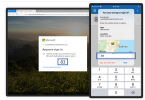britechguy
Well-Known Member
- Reaction score
- 5,075
- Location
- Staunton, VA
So, I've been wading into the waters of 2FA using 2FAS (also Google Authenticator, but not right now), and it works well enough, but I find it a grand PITA to have to enter those 6 digit codes after also doing the classic loginID/password sequence. There are some services, Google being one of them, that will throw up a message (and not a text message) on the screen asking, "Is that really you?," to which you respond using a yes/no button.
If I'm going to attempt to get many of my clients to accept 2FA, the 6-digit code entry will be a no-go, but the, "Is it you?," method would easily fly. Is there a way to force that to occur via some Authenticator App setting I'm missing?
If I'm going to attempt to get many of my clients to accept 2FA, the 6-digit code entry will be a no-go, but the, "Is it you?," method would easily fly. Is there a way to force that to occur via some Authenticator App setting I'm missing?

